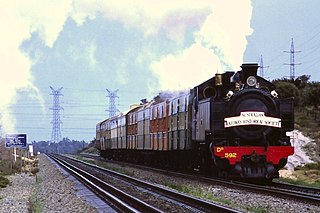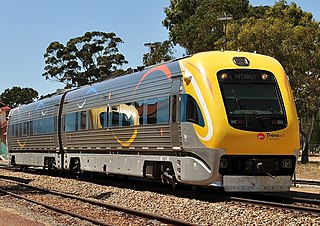
The AvonLink is a rural passenger train service in Western Australia operated by Transwa between Midland and Northam.

The Prospector is a rural passenger train service in Western Australia operated by Transwa between East Perth and Kalgoorlie. On this service, two trains depart almost at the same time in opposite directions, one travelling between East Perth and Kalgoorlie, and the other between Kalgoorlie and East Perth. The original vehicles ordered in 1968 for trains providing this service were replaced in 2004 with vehicles capable of reducing journey times to 6 hours 45 minutes.

The Australind is a currently suspended rural passenger train service in Western Australia operated by Transwa on the South Western Railway between Perth and Bunbury.

Western Australian Government Railways (WAGR) was the operator of railway services in the state of Western Australia between October 1890 and June 2003. Owned by the state government, it was renamed a number of times to reflect extra responsibility for tram and ferry operations that it assumed and later relinquished. Westrail was the trading name of WAGR from September 1975 until December 2000, when the WAGR's freight division and the Westrail name and logo were privatised. Its freight operations were privatised in December 2000 with the remaining passenger operations transferred to the Public Transport Authority in July 2003.

The Midland Railway of Western Australia (MRWA) was a railway company that built and operated the Midland line in Western Australia. It was listed on the London Stock Exchange. Although having its headquarters in London, it had no association with the English Midland Railway.

Railways in Western Australia were developed in the 19th century both by the Government of Western Australia and a number of private companies. Today passenger rail services are controlled by the Public Transport Authority through Transperth, which operates public transport in Perth, and Transwa, which operates country passenger services. Journey Beyond operates the Indian Pacific.

The ADK class are a class of diesel multiple units that were previously operated by Western Australian Government Railways (WAGR) in Perth, and later Transdev Auckland on Auckland's suburban rail network, and are currently operated by MetroBus in Maputo, Mozambique. Originally built by Commonwealth Engineering and the Midland Railway Workshops for WAGR in the late 1960s, all but one were sold in 1993 to New Zealand Rail, and were then owned by Auckland Transport. The units were completely withdrawn from service in New Zealand on 5 December 2014, following completion of electrification of Auckland's network.
The Northern Railway has had a number of meanings in Western Australian railway history.

The WAGR X class is a now-withdrawn class of diesel locomotives built by Beyer, Peacock & Company and Metropolitan-Vickers, Bowesfield Works, Stockton-on-Tees for the Western Australian Government Railways (WAGR) between 1954 and 1956. Several members of the class have been preserved.

The WAGR Dd class was a class of 4-6-4T tank locomotive operated by the Western Australian Government Railways (WAGR) between 1946 and 1972.

The Western Australian Government Railways operated many unique steam, diesel and electric locomotive classes. Often suffering from lack of available funds the WAGR locomotive fleet often consisted of locomotives far older than their expected operational life. Only one electric locomotive was operated by the government during the WAGR years.

Western Australian Government Railways railway system during its peak operational time in the 1930s to 1950s was a large system of over 6,400 kilometres (4,000 mi) of railway line.

The WAGR WCA class railcars and WCE class trailers were built by Comeng, Granville for the Western Australian Government Railways in 1971 to operate the new Prospector service between East Perth and Kalgoorlie. At the time of their construction the WCA class units were the longest and fastest diesel railcars in the world.

The Transwa WDA/WDB/WDC and WEA/WEB classes are two classes of railcars built by United Goninan, Broadmeadow for Transwa in 2004–2005 to replace the WAGR WCA/WCE class railcars on the AvonLink, MerredinLink and Prospector services in Western Australia.

The Westrail ADP/ADQ class is a retired class of railcars built by Comeng, Bassendean for Westrail in 1987 to operate the Australind service between Perth and Bunbury. Operation and ownership of the fleet was transferred to Transwa when Westrail was superseded by Transwa in 2003.

The WAGR ADF class was a six member class of diesel-electric railcars operated by the Western Australian Government Railways between 1949 and 1975.

The WAGR AI class was a petrol-driven railmotor or railcar operated between 1935 and 1949 by the Western Australian Government Railways (WAGR).

The WAGR AO class was a three member class of petrol-driven railmotors or railcars operated between 1922 and 1950 by the Western Australian Government Railways (WAGR). The motorised chassis were supplied by the Motor Rail and Tram Car Co Ltd, of Bedford, England in 1922. The Agent General for Western Australia ordered them through agents Flower & Davies and they were delivered to Midland Railway Workshops for bodies to be fitted.
The WAGR ADG class was an 18 member class of diesel railcars operated by the Western Australian Government Railways between 1954 and 1992.
The WAGR ADH class was a four member class of diesel railcars operated by the Western Australian Government Railways.

















